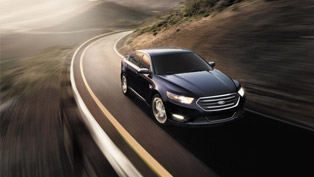The New Ford Taurus Sculpted for Optimal Fuel Economy
To the untrained eye, it's just another facet in the chiseled, muscular shape of the expressive new Ford Taurus. As the sunlight glints off the rear decklid of Ford's poised new driver's sedan standing ready to hit the road, the slight but precise lip of the decklid reflects the rays. It is just one of many interesting visual details created by talented designers from Ford's Dearborn, Mich., design studio for the new Taurus.
Yet they weren't in the design studio when they shaped the car's rear decklid lip. They were in the wind tunnel, searching for just the right design statement… and some miles per gallon while they were at it. That's because the design of the new Taurus has to do more than look good.
"Even with the artistic license that comes with my job, I still need lots of help to outwit the laws of physics," says Earl Lucas, chief designer of the new Ford Taurus.
With Ford's commitment for each of its new models to be the best or among the best in its segment for fuel economy, every aspect of the new car's shape was scrutinized for its contribution to fuel economy.
Because it had to cheat the wind as much as please the eye, Lucas got help from a skilled team of Ford aerodynamicists whose commitment to achieving excellent fuel economy for the new-generation Taurus matched his team's zeal to create a new design full of attitude and appeal.
Enter Ilze Liepa, aerodynamic supervisor for the new model. Today, designers work hand in hand with aero specialists. Aerodynamic efficiency is so critical to fuel efficiency that aero engineers are consulted on every facet of a vehicle design.
"Yes, every facet," says Liepa, "especially that decklid."
Liepa and her team have sophisticated computational fluid dynamics tools to predict aerodynamic performance of various design alternatives created by the design team. And they have dedicated Ford wind tunnel facilities to prove out their findings. Designers like Lucas depend on aerodynamics experts like Liepa because sometimes what looks aerodynamically efficient is actually the opposite.
"Aerodynamics isn't always intuitive," says Liepa, "and a really great aerodynamic shape might not be pleasing to the eye. That's why we work together so closely."
It would be the almost unnoticeable decklid lip that would test the two teams' collaboration skills. The decklid shape was one of the final strokes of the new car's design.
"Collaboration doesn't mean compromise," says Lucas. "We had a very specific vision for the design language of the new Taurus. And that's why we went the extra mile in the wind tunnel."
Liepa and her team also had clear objectives to minimize fuel consumption.
"We wanted a defined lip on the decklid to shape air currents at the rear of the vehicle. The objective is to minimize the wake created by the car in motion – and to shape the wake. This makes a significant difference in miles per gallon."
The collaboration between designers and aerodynamicists paid dividends. Its 0.33 coefficient of drag helps the base Taurus deliver EPA sticker values of 18 miles per gallon city and 28 highway.
The high-performance Taurus SHO, with a 365-horsepower twin-turbo EcoBoost™ V-6, delivers EPA-rated fuel economy of 17 mpg city and 25 highway. Aerodynamic fine-tuning and a 0.32 coefficient of drag help the Taurus SHO deliver the power of a normally aspirated V-8, without compromise to its V-6 fuel economy.
Outstanding fuel economy is often the sum of many small details like the Taurus decklid lip. Such details are sweated by experts behind the scenes whom Taurus customers are never likely to meet.
As Taurus neared its final shape, the creative tension between the two groups culminated in a team of designers invading the wind tunnel to make the final decisions on the decklid.
As various design iterations were tested in 70-mph blasts of air and telltale smoke traces at the hands of the aerodynamicists, Lucas and his designers sculpted their final tweaks in clay right there.
"The fur didn't fly, but I'm sure some bits of clay did that day," Liepa remembers.
"I think both sides won that day," says Lucas. "Looking at that lip, you'd be amazed at how much effort and attention to detail went into that decklid."
The new Taurus can literally claim to have been sculpted in the wind tunnel to make it ready for the romance of the road, not the fuel station.
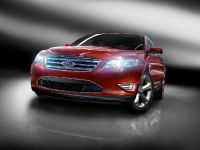
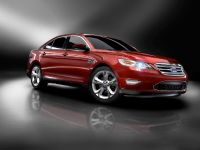
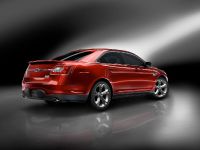
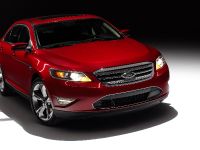
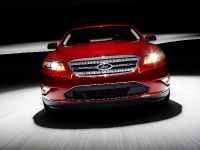
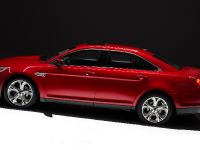
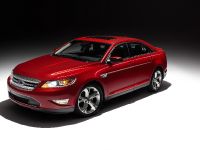
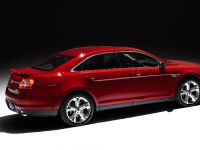
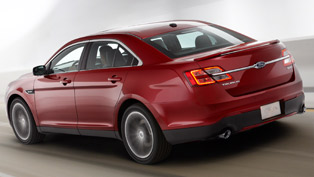
![2013 Ford Taurus SHO at the race track [HD video]](http://www.automobilesreview.com/uploads/2012/05/ford-taurus-big.jpg)
